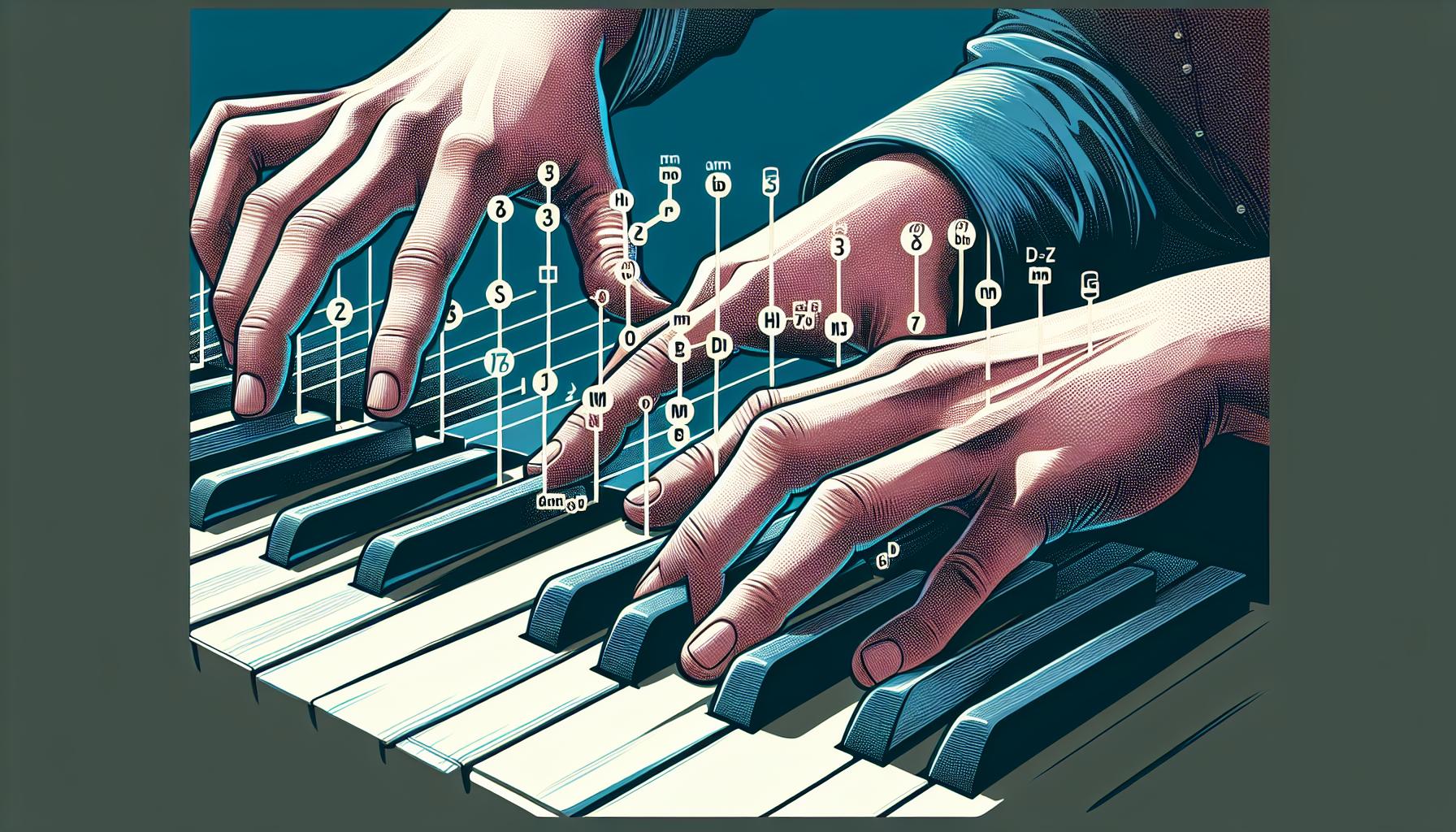Diving into the world of jazz can be an exhilarating adventure, especially when it comes to mastering the keyboard. Jazz, with its rich harmonies and soulful melodies, invites musicians to explore a vast landscape of sound and emotion. For those just starting their journey, understanding the basic jazz chords is the first step toward unlocking this musical treasure trove.
The beauty of jazz chords lies in their versatility and depth, offering a palette from which to paint endless auditory pictures. Whether you're a beginner eager to get your fingers gliding over those keys or a seasoned player looking to brush up on your fundamentals, getting a solid grip on these chords is essential. They're the building blocks of jazz's intricate language, and learning them opens up a world of improvisation and creativity.
Understanding Jazz Chords
When it comes to jazz, chords are the very essence that fuels the genre's unmistakable sound. Unlike other music styles, jazz chords infuse songs with rich, complex, and often unexpected harmonies. For keyboard players, mastering these chords isn't just about learning shapes and positions; it's about diving into the soul of the music.
Jazz chords are typically built on the principles of extended harmony. This means that they not only include the basic triad (the root, third, and fifth notes of a scale) but also incorporate various combinations of seventh, ninth, eleventh, and thirteenth intervals. These extensions add depth and color, making the chords sound fuller and more interesting.
Starting with the Basics
The journey into jazz often begins with the major 7th, minor 7th, and dominant 7th chords. They're the backbone of many jazz standards and provide a solid foundation for understanding jazz harmony. Here's a brief overview:
- Major 7th Chords: These convey a sense of completeness and tranquility. They consist of a major triad plus a major seventh.
- Minor 7th Chords: Offering a softer, more reflective sound, they're formed by adding a minor seventh to a minor triad.
- Dominant 7th Chords: Known for their tension and resolution, these chords add a minor seventh to a major triad.
Adding Color with Extensions
After getting comfortable with the 7th chords, the next step is exploring extensions. These notes, added to the 7th chords, introduce new layers of sound. Here's how they contribute to jazz's unique flavor:
- Ninth Chords: Whether major, minor, or dominant, adding a ninth can give chords a more sophisticated edge.
- Eleventh and Thirteenth Chords: These further extend the harmony, allowing for even richer, more complex sounds.
Chord Voicings and Inversions
In jazz, it's not just what notes you play but how you play them. Chord voicings refer to the arrangement of a chord's notes across the keyboard. By experimenting with different voicings, keyboard players can find the sound that best fits the mood they're aiming for. Similarly, chord inversions—playing the chord with a different note in the bass—can drastically change the chord's character.
Importance of Basic Jazz Chords for Keyboard Players

When diving into the rich world of jazz, keyboard players quickly find that basic jazz chords are the cornerstone of their musical journey. These chords serve as the fundamental building blocks for crafting the unique, complex sounds that define jazz music. They're especially crucial for those new to jazz, providing a solid groundwork from which they can explore more intricate harmonies and improvisations.
For keyboard players, mastering basic jazz chords means much more than just adding a few new sounds to their repertoire. It's about developing a deep understanding of jazz's harmonic landscape. Major 7th, minor 7th, and dominant 7th chords aren't just variations of triads; they are the heartbeats of jazz harmony, each bringing its own flavor and emotional depth to the music. These chords offer completeness, reflection, and a means to resolve tension, respectively, creating a rich tapestry of sound that's both captivating and complex.
Beyond the foundational chords, the journey into extensions like ninths, elevenths, and thirteenths pulls the keyboard player deeper into the realm of jazz. These extended chords add layers of sophistication and color that are essential for the nuanced expressions jazz is known for. It's not just about the chords themselves but how they're voiced and inverted that can dramatically alter the mood and character of a piece.
| Chord Type | Role in Jazz |
|---|---|
| Major 7th | Offers completeness and warmth |
| Minor 7th | Adds reflection and moodiness |
| Dominant 7th | Creates tension and resolution |
The importance of chord voicings and inversions cannot be overstated. In jazz, it's often not just what chords are played, but how they are played that counts. Different voicings can emphasize certain notes within the chord, bringing out unique textures and emotions. Similarly, inversions can drastically change the bass line and harmony, offering fresh perspectives and sounds within the same chord framework.
As keyboard players delve into jazz, they learn to weave these chords together, creating intricate musical tapestries that speak to the listener's soul. The journey from basic triads to the complex extended chords illustrates a growth in understanding and skill, marking the evolution of a musician capable of expressing a vast array of emotions and stories through their instrument.
Common Basic Jazz Chords to Master

Diving into the world of jazz starts with mastering a few fundamental chords. For keyboard players, these basic jazz chords are the building blocks for creating the rich, sophisticated sounds characteristic of this genre. Let’s explore some of the essential chords that every aspiring jazz keyboardist should know.
Firstly, Major 7th chords are a staple in the jazz repertoire. They’re formed by combining a root note with a major third, perfect fifth, and a major seventh. The sound of a major 7th chord is full and complete, often evoking a sense of resolution and contentment. For example, a C major 7th chord is made up of C, E, G, and B notes.
Next are the Minor 7th chords, which include a root, a minor third, a perfect fifth, and a minor seventh. These chords introduce a reflective or somber tone into the music, perfect for expressing a wide range of emotions. An A minor 7th chord, for instance, consists of A, C, E, and G.
Dominant 7th chords are another crucial component. These chords add a taste of tension and anticipation, urging the music forward. They consist of a root, a major third, a perfect fifth, and a minor seventh. The C7 chord, comprised of C, E, G, and B♭, is a classic example and a frequent visitor in blues progressions as well.
In addition to these basic types, jazz chords often incorporate extensions like the ninth, eleventh, and thirteenth. These extensions add layers of complexity and sophistication, enriching the chord’s texture. For instance, adding a D (the ninth) to a C major 7th chord transforms it into a Cmaj9, introducing an additional level of harmonic depth.
Learning about chord voicings and inversions is also crucial for keyboard players. Voicings alter the chord’s texture and mood by changing the order and octave of the notes. Inversions, on the other hand, rearrange the chord’s structure by placing notes other than the root note in the bass position. These techniques allow musicians to convey various emotions and textures, making their performances more dynamic and expressive.
For a quick reference, here’s a summary of the chords discussed:
Practice Tips for Perfecting Jazz Chords on Keyboard

Mastering jazz chords on the keyboard is a thrilling adventure that demands dedication, practice, and a touch of creativity. To help musicians on this journey, here are several tips designed to enhance their practice sessions and improve their chord mastery.
Start With the Basics
Before diving into complex chords and progressions, it's crucial to ensure a solid understanding of the basic major, minor, and dominant 7th chords. These foundational elements are the building blocks of jazz and will serve as a springboard for more advanced study. Practicing these chords in various keys not only builds muscle memory but also aids in developing a keen ear for jazz harmony.
Employ Slow Practice
One of the most effective strategies for mastering jazz chords is to practice slowly. Slow practice allows musicians to focus on the accuracy of finger placement, ensuring each note of the chord rings clear and true. It also provides the opportunity to really listen to the chords and understand their emotional and harmonic context within a piece of music.
Use a Metronome
Rhythm is just as important as harmony in jazz music. Utilizing a metronome during practice sessions can drastically improve a musician's timing and rhythmic accuracy. Starting at a slow tempo, players should practice their chords and progressions, gradually increasing the speed as they become more comfortable. This disciplined approach helps in building a solid rhythmic foundation essential for jazz performance.
Experiment With Chord Inversions
Chord inversions offer a way to play the same chord in different positions on the keyboard, providing a smoother transition between chords and adding interest to the harmonic progression. Keyboard players should spend time practicing chord inversions in isolation before integrating them into songs. This practice will vastly improve their ability to navigate the keyboard and enrich their overall sound.
Integrate Extensions and Voicings
As mentioned earlier, jazz chords are notorious for their complexity, often including extensions like the 9th, 11th, and 13th. Practicing these extended chords helps musicians familiarize themselves with the fuller, more complex sound of jazz. Additionally, experimenting with different voicings can significantly alter the texture and mood of the music, giving keyboard players much-needed versatility in their playing.
Conclusion
Diving into the world of jazz chords on the keyboard opens up a universe of musical expression. Starting with the basics and gradually incorporating more sophisticated techniques ensures a solid foundation. Remember, mastering these chords isn't just about technical skill—it's also about feeling the music. So take your time, practice diligently, and let your creativity flow. With patience and passion, you'll soon find yourself playing jazz chords with ease and confidence, adding a rich layer of complexity to your musical repertoire.
Harlan Kilstein began playing piano during covid with no piano background at all. He taught himself how to play learning what to do and what not to do.
Today he's an advanced intermediate player and can help you grow in your skills because he learned all this on his own.








